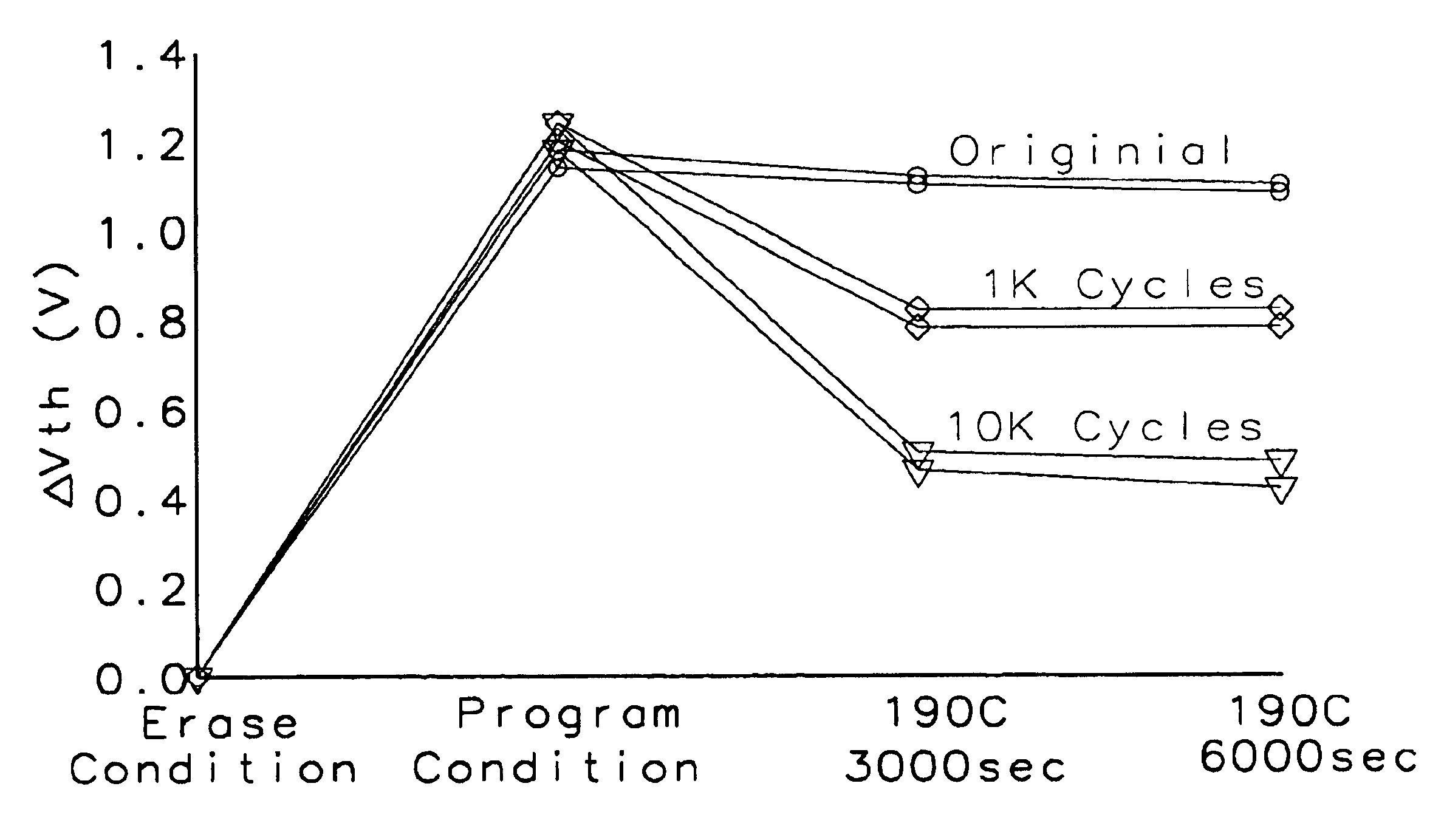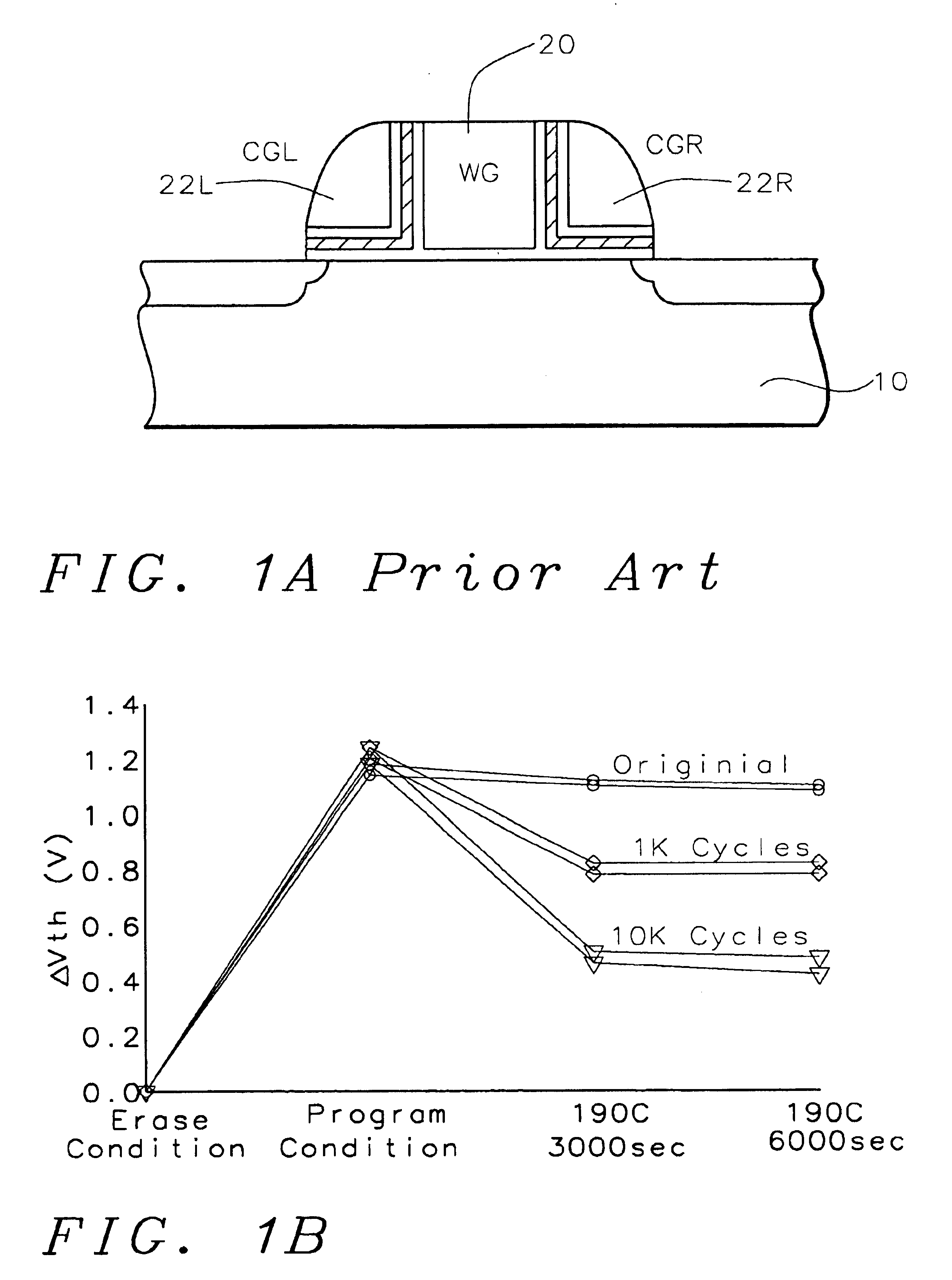Twin insulator charge storage device operation and its fabrication method
a charge storage device and twin insulator technology, applied in semiconductor devices, instruments, electrical devices, etc., can solve the problems of limited hot hole and che combination approach, and achieve the effect of high density nand and easy integration into a conventional cmos platform
- Summary
- Abstract
- Description
- Claims
- Application Information
AI Technical Summary
Benefits of technology
Problems solved by technology
Method used
Image
Examples
first embodiment
[0057]It is implemented for device operation of the first embodiment to insert one hot hole erasure after every n (100 or 1000) cycles of CHE program and F-N erase as shown in FIG. 6. Hot holes generated by band to band transition can be injected into the nitride portion at the L-shaped corner and neutralize the accumulated electrons there as long as the control gate (CG) channel length is within the several hole mean free path by applying a negative bias on the word gate. (See U.S. patent application Ser. No. 09 / 810,122—Halo 00-004—Word gate negative hole injection). Therefore if hot hole damage is tolerable up to 1K cycles and hot hole injection is required after 100 F-N erasures, then the endurance cycle providing the proper operating threshold voltage (Vt) window is extended to 100×1K=100K cycles. However, this Hot Hole and CHE combination approach is still limited by Hot Hole endurance comparing to CHE-F-N endurance.
second embodiment
[0058]The device cross-sectional structure of the second embodiment along the 1′ direction is shown in FIG. 7 as well as the top view of array architecture shown in FIG. 8. The bit diffusion is in between a pair of the control gates partitioned by memory spacer 115. The bit diffusion consists of memory diffusion 103 and overlying raised diffusion 141. The control gate consists of the control gate polysilicon 140, underlying ONO (bottom oxide 111, storage nitride 112 and top oxide 113) and underlying control gate channel 101. The pair of the control gates are connected to each other at the end of diffusion bit. The control gate and the bit diffusion run along the 2nd direction crossing the 1st direction. Their contacts are placed at the end of the bit diffusion. The word gate consisting of word gate polysilicon 142, underlying word gate oxide 118 and underlying substrate 100 is on the other side of the control gate partitioned by CG-WG isolation dielectrics 118. The word gates are co...
third embodiment
[0090]Referring to FIGS. 29A, B, C and C1, FIG. 29C is a cross section along word gate polysilicon 240 (cross-section G-G′) and FIG. 29C1 is along the word gate space (cross-section F-F′). After oxide planarization, adjacent every pair of diffusions are connected together by local wiring 250 as shown in FIG. 29C1. The bit contact 251 is paced on the center of the local wiring 250. The bit contacts are connected by the 1st metal 252. The control gate contact 260 and the word contact 261 are placed at the end of the word line as shown in FIGS. 29A and C. The third embodiment is therefore completed.
[0091]A top view and a cross sectional structure of the fourth embodiment are shown in FIG. 30A and FIG. 30B. It is simply replacing the floating gate in the conventional NAND by nitride 312 besides reducing the cell size. The memory cell structure is of subtracting the word gate 242 in FIG. 23B of the third embodiment and forming a diffusion area instead. The unit cell is shown in FIG. 30 a...
PUM
 Login to View More
Login to View More Abstract
Description
Claims
Application Information
 Login to View More
Login to View More - R&D
- Intellectual Property
- Life Sciences
- Materials
- Tech Scout
- Unparalleled Data Quality
- Higher Quality Content
- 60% Fewer Hallucinations
Browse by: Latest US Patents, China's latest patents, Technical Efficacy Thesaurus, Application Domain, Technology Topic, Popular Technical Reports.
© 2025 PatSnap. All rights reserved.Legal|Privacy policy|Modern Slavery Act Transparency Statement|Sitemap|About US| Contact US: help@patsnap.com



